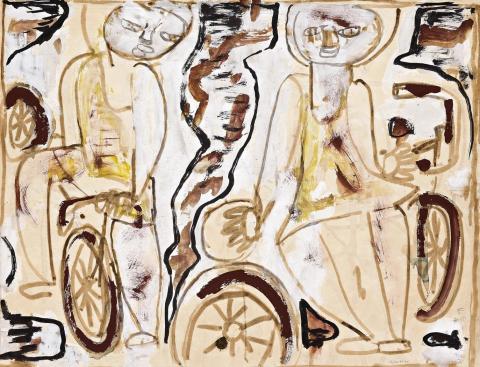SCOOTERS, 1950
IAN FAIRWEATHER
gouache and watercolour on paper
58.5 x 72.5 cm
signed, dated and inscribed lower right: IF [in Chinese characters] / 1900 [in Chinese characters] 50 / Scooters
Collection of Lina Bryans, Melbourne
Thence by descent
Private collection, Melbourne
Fairweather: a Retrospective Exhibition, Queensland Art Gallery, Brisbane, 3 June – 4 July 1965; Art Gallery of New South Wales, Sydney, 21 July – 22 August 1965; National Gallery of Victoria, Melbourne, 9 September – 10 October 1965; National Gallery of South Australia, Adelaide, 26 October – 21 November 1965; Western Australian Art Gallery, Perth, 9 December 1965 – 16 January 1966; Tasmanian Museum and Art Gallery, Hobart, 10 February – 13 March 1966, cat. 85
Ian Fairweather 1891-1974, National Gallery of Victoria, Melbourne, 25 September – 6 November 1991, cat. 16
Fairweather, Queensland Art Gallery, Brisbane, 1 October – 27 November 1994; National Gallery of Victoria, Melbourne, 17 December 1994 – 19 February 1995, cat. 16 (label attached verso)
The Drawings of Ian Fairweather, National Gallery of Australia, Canberra, 21 June – 24 August 1997; Art Gallery of New South Wales, Sydney, 17 October – 7 December 1997; Queensland Art Gallery, Brisbane, 7 February – 29 March 1998, cat. 23 (label attached verso)
Fisher, T., The Drawings of Ian Fairweather, National Gallery of Australia, Canberra, 1997, pp. 14, 20, pl. 7 (illus.)
Bail, M., Fairweather, Murdoch Books, Sydney, revised edition, 2009, cat. 89, pp. 95, 251, pl. 72 (illus.)
In the introduction to the catalogue for Ian Fairweather's nationally touring retrospective exhibition of 1965, curator Robert Smith wrote, ‘In his paintings Ian Fairweather has always been concerned with people – not as individuals, not as types, but as people: part of the vast unfolding tapestry of life’.1 In Scooters, 1950 line effortlessly captures and expresses movement as much through the figures of the young people as the scooters themselves. Murray Bail in his monograph on Fairweather refers to its ‘deliberate awkwardness’.2 It is an awkwardness, to my mind, that extends the feeling of movement and captures that feeling of momentary imbalance one may have when riding such wheeled vehicles – riding a bike or scooter is not always an elegant activity. This is allied to a feeling of freedom, colour free of form, line following its own circuitous fascinations, tapestry-like in its frontal, frieze-like and flattened patterning. There is a sense that the pigment is about to free itself from reality, the painting beautifully balanced between figuration and abstraction. As Fairweather said, ‘... I don't feel I am a complete abstractionist – I still like – perhaps mistakenly in this age of collectivism – to retain some relic of subjective reality’.3 The seeming simplicity of the work is arresting – a few gestures of line and colour and a work of fascination is created – a sure measure of Fairweather's masterly creativity. As fellow-artist and art critic James Gleeson wrote about Fairweather's art in general, ‘He can evoke a world of subtly fluctuating values with a palette almost entirely restricted to a range of earthy browns and greys that lie anywhere between black and white and are cooled or warmed with suggestions of blue or rose. With such limited means he conjures up organizations of colour that rival the lustre of a grey pearl’.4
After such fulfillment, should one dig deeper? Some see the figures of a girl (two girls?) and boy dramatically divided by a jagged fissure.5 Yet, their faces look too content for such perturbations. The outlining by black-edged, torn shapes gives emphasis to their figures. Moreover, while being an effective compositional device with an interlocking play between surface and the illusion of depth, it does remind that riding a scooter can be bumpy at times, for Fairweather's embrace is wide.
1. Smith, R., Fairweather: A Retrospective, Queensland Art Gallery, Brisbane, 1965, unpaginated
2. Bail, M., Fairweather, Murdoch Books, Sydney, revised edition, 2009, p. 94
3. The artist quoted in Bail, ibid., p. 140
4. Gleeson, J., 'Painting in Australia since 1945', Art and Australia, Ure Smith, Sydney, vol. 1, no. 1, May 1963, p. 7
5. Bail, op. cit., p. 94
DAVID THOMAS
